Sagittarius constellation lies in the southern sky. It is one of the constellations of the zodiac. It represents the archer.
Sagittarius is usually depicted as a centaur holding a bow and arrow. The constellation’s symbol is ♐. It is also associated with Crotus, the satyr who kept company of the Muses on Mount Helicon. Sagittarius is one of the largest southern constellations. It is easy to find because it lies on the Milky Way and its brightest stars form an asterism known as the Teapot. Like other zodiac constellations, Sagittarius was first catalogued by the Greek astronomer Ptolemy in the 2nd century.
The constellation contains the Arches Cluster, the Quintuplet Cluster with the luminous Pistol Star, the Galactic centre, the radio source Sagittarius A, and a number of very famous deep sky objects, including the Sagittarius Dwarf Elliptical Galaxy, the Sagittarius Dwarf Irregular Galaxy, Barnard’s Galaxy, the Bubble Nebula, and as many as 15 Messier objects, among them the Sagittarius Star Cloud (Messier 24), the Omega Nebula (Messier 17), Messier 18, the Lagoon Nebula (Messier 8), and the Trifid Nebula (Messier 20).
Facts, location and map
Sagittarius is the 15th largest constellation in the sky. It occupies an area of 867 square degrees. It is located in the fourth quadrant of the southern hemisphere (SQ4) and can be seen at latitudes between +55° and -90°. The neighboring constellations are Aquila, Capricornus, Corona Australis, Indus, Microscopium, Ophiuchus, Scutum, Scorpius, Serpens Cauda and Telescopium.
The constellation name Sagittarius is pronounced /sædʒɪˈtɛəriəs/. In English, the constellation is known as the Archer. The genitive form of Sagittarius, used in star names, is Sagittarii (pronunciation: /ˌsædʒəˈtɛəriaɪ/). The three-letter abbreviation, adopted by the International Astronomical Union (IAU) in 1922, is Sgr.
Sagittarius has seven stars brighter than magnitude 3.00 and three stars located within 10 parsecs (32.6 light years) of Earth. The brightest star in Sagittarius is Kaus Australis, Epsilon Sagittarii (spectral class B9.5 III), with an apparent magnitude of 1.79. The nearest star is Ross 154 (V1216 Sagittarii, spectral class M3.5V), located at a distance of only 9.69 light years from Earth.
The constellation Sagittarius contains 17 named stars. The proper names of stars that have been officially approved by the International Astronomical Union (IAU) are Ainalrami, Albaldah, Alnasl, Arkab Posterior, Arkab Prior, Ascella, Belel, Gumala, Kaus Australis, Kaus Borealis, Kaus Media, Nunki, Pincoya, Polis, Rukbat, Sika, and Terebellum.
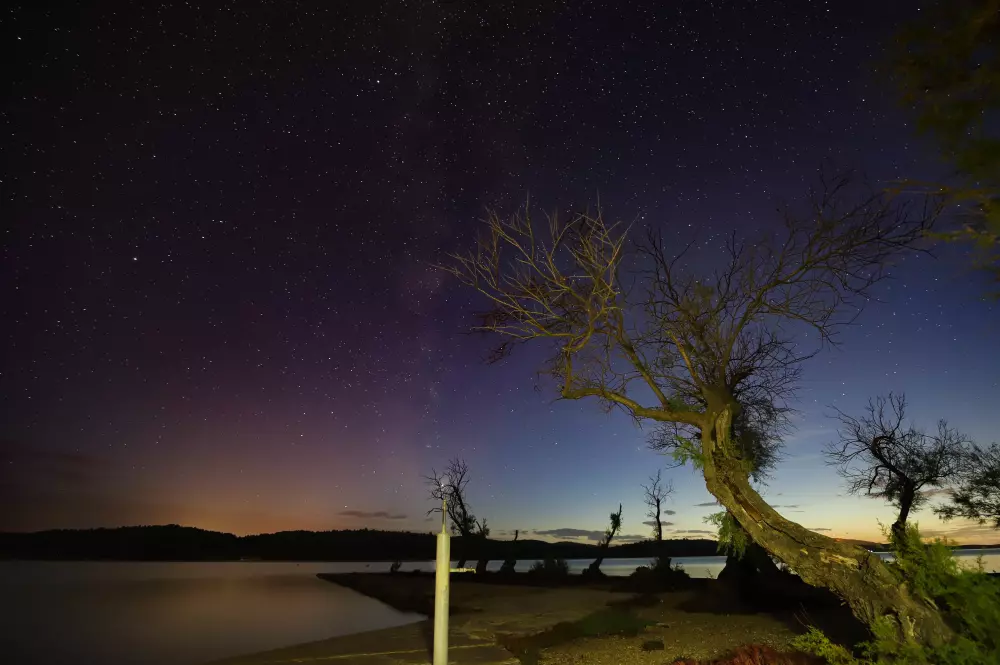
Sagittarius, image: Constellation Guide
The constellation has 32 stars with confirmed planets. OGLE-2006-BLG-109L (spectral class M0V) has two known exoplanets, suspected analogs of Jupiter and Saturn, discovered in 2008. The planets SWEEPS-04, orbiting the magnitude 18 star SWEEPS J175853.92−291120.6 (F5V), and SWEEPS-11, with the parent star SWEEPS J175902.67−291153.5, are among the most distant exoplanets known, both located at a distance of 27,710 light years from Earth. The star HD 169830 (F9V) is orbited by two Jupiter-like planets, discovered in 2000 and 2013. HD 190647 (G5IV) has a known exoplanet, discovered in 2007. A transiting planet was spotted orbiting the magnitude 16 eclipsing variable star OGLE-TR-10 (G2V) in 2002. The red dwarf MOA-2009-BLG-387L, located almost 20,000 light years away, is host to an orbiting planet with a mass between 1.0 and 6.7 times that of Jupiter. A gas giant planet was discovered orbiting the orange dwarf HD 164604 (K3.5Vk) in 2010.
Other stars with confirmed exoplanets include HD 171238 (G8 V), HD 179949 (F8 V), HD 181720 (G1V), HD 187085 (G0V), WASP-67 (K0V), MOA-2011-BLG-293L (M1.5V), MOA-2009-BLG-319L (K8V), HD 181342 (K0III), HD 180902 (K0III/IV), OGLE-TR-56 (G), OGLE-2003-BLG-235L (K5), OGLE-2005-BLG-169L (M), MOA-2007-BLG-192L, and MOA-2007-BLG-400L (M3V).
Sagittarius belongs to the Zodiac family of constellations, along with Aries, Taurus, Gemini, Cancer, Leo, Virgo, Libra, Scorpius, Capricornus, Aquarius and Pisces.
Sagittarius contains 15 Messier objects: Messier 8 (M8, NGC 6523, Lagoon Nebula), Messier 17 (M17, NGC 6618 Omega, Swan, Horseshoe or Lobster Nebula), Messier 18 (M18, NGC 6613), Messier 20 (M20, NGC 6514, Trifid Nebula), Messier 21 (M21, NGC 6531), Messier 22 (M22, NGC 6656, Sagittarius Cluster), Messier 23 (M23, NGC 6494), Messier 24 (M24, NGC 6603, Sagittarius Star Cloud), Messier 25 (M25, IC 4725), Messier 28 (M28, NGC 6626), Messier 54 (M54, NGC 6715), Messier 55 (M55, NGC 6809), Messier 69 (M69, NGC 6637), Messier 70 (M70, NGC 6681) and Messier 75 (M75, NGC 6864). There are no meteor showers associated with the constellation.
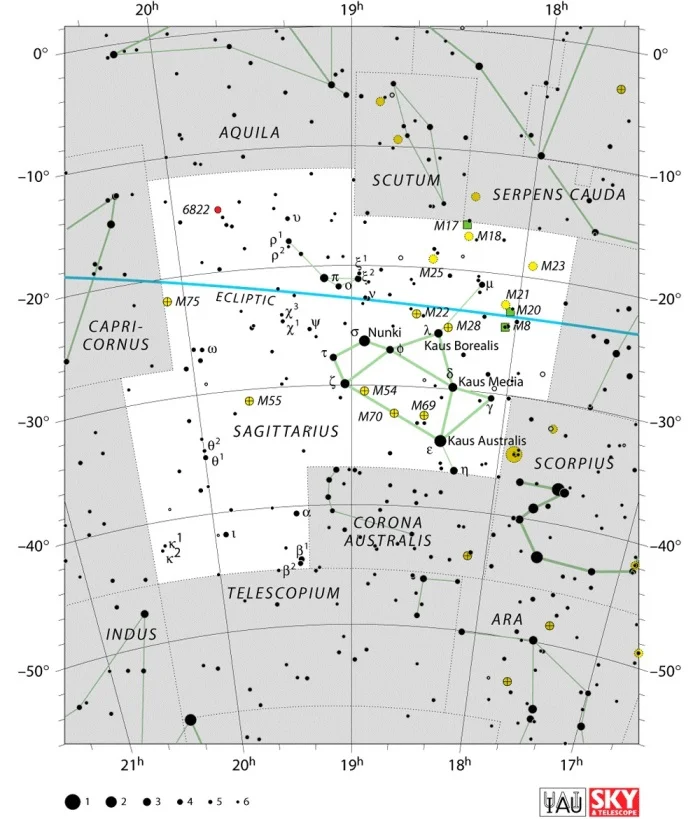
Sagittarius constellation map by IAU and Sky&Telescope magazine
Mythology
In Greek mythology, Sagittarius represents a centaur, a half human, half horse creature with the torso of a man and the body and four legs of a horse. The centaur is depicted as aiming an arrow toward the heart of the neighbouring constellation Scorpio, represented by the red supergiant star Antares. Sometimes Sagittarius is wrongly identified as the centaur Chiron, represented by the constellation Centaurus.
Sagittarius constellation has its roots in Sumerian mythology. Eratosthenes associated it with Crotus, a mythical creature with two feet and a satyr’s tail, who was the nurse to the nine Muses, daughters of Zeus.
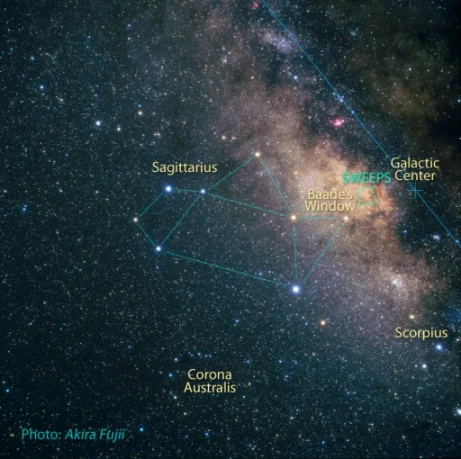
Sagittarius constellation, Baade’s Window and the Teapot, photo: NASA, ESA, Z. Levay (STScI) and A. Fujii
Eratosthenes argued that the constellation really represented a satyr and not a centaur. According to the Roman author Hyginus, Crotus was the son of Pan and the archer the constellation was named after. Crotus invented archery and lived on Mount Helicon. Because he was close to the Muses, they were the ones who asked Zeus to place him in the sky.
In Babylonian mythology, Sagittarius is associated with the centaur-like god Nergal, and depicted with two heads – one human and one panther – and also wings, and the stinger of a scorpion positioned above a horse’s tail.
Major stars in Sagittarius
Kaus Australis – ε Sagittarii (Epsilon Sagittarii)
Epsilon Sagittarii is a binary star approximately 143 light years distant. It is a blue class B giant with an apparent magnitude of 1.79 and a luminosity 375 times that of the Sun. Kaus Australis is the brightest star in the constellation Sagittarius and the 36th brightest star in the sky. It has a faint 14th magnitude companion 32 arc seconds away.
The star’s traditional name, Kaus Australis, comes from the Arabic word for “bow” (qaws) and the Latin word for “southern” (australis). The star marks the base of the archer’s bow. Together with the stars Delta (Kaus Media) and Lambda Sagittarii (Kaus Borealis), Epsilon Sagittarii represents the archer’s bow.
Nunki – σ Sagittarii (Sigma Sagittarii)
Sigma Sagittarii is the second brightest star in the constellation Sagittarius. It is a hydrogen fusing dwarf star that belongs to the spectral type B2.5 V. It has an apparent magnitude of 2.1. The star has a luminosity 3,300 times that of the Sun and about seven solar masses. It is a very fast rotator, spinning with a speed of more than 200 kilometres per second, which is about 100 times faster than the Sun. The star lies approximately 228 light years from Earth.
Sigma Sagittarii is sometimes also known as Nunki. This is the star’s modern name, which is either Babylonian or Assyrian in origin. The significance of the name is unknown, except that it is a proper name. It was recovered by archaeologists and made public by Richard Hinckley Allen in his book Star names, their lore and meaning.
Nunki has a faint (magnitude 9.5) companion about 5.2 arc minutes away. Nunki is located close to the eclipic and it can sometimes be occulted by the Moon and, very rarely, by planets. The star was last occulted by a planet on November 17, 1981, when Venus passed in front of it.
Sigma Sagittarii is also notable for being the brightest star that can be occulted by an exterior planet. This, however, only applies to Mars and it happens very rarely. The last occultation occurred on September 3, 423.
Kaus Media – δ Sagittarii (Delta Sagittarii)
Delta Sagittarii is a multiple star system approximately 306 light years distant in the constellation Sagittarius. It has an apparent magnitude of 2.72 and belongs to the spectral type K3III.
Delta Sagittarii has a radius 62 times solar, a mass about five times solar, and is 1180 times more luminous than the Sun. The star’s traditional name, Kaus Media, means “the middle bow.” The primary star in the Delta Sagittarii system has three dim companions: Delta Sagittarii B, a 14th magnitude star 26 arc seconds away, Delta Sagittarii C, a 15th magnitude star 40 arc seconds away, and Delta Sagittarii D, a 13th magnitude star 58 arc seconds away.
The Delta Sagittarii system is known in fiction from William R. Forstchen’s 1969 novel Into the Sea of Stars. It is the destination of a crew of women who travel onboard the Colonial Unit 122 to the Delta Sagittarii star system carrying a supply of sperm purged of the Y chromosome.
Kaus Borealis – λ Sagittarii (Lambda Sagittarii)
Lambda Sagittarii is an orange giant star, belonging to the spectral class K1+IIIb, with an apparent magnitude of 2.82. It is approximately 77.3 light years distant. It has a radius 11 times solar and is 52 times more luminous than the Sun. Lambda Sagittarii is what astronomers sometimes refer to as a clump star: one undergoing the final stages of its existence, but stable nevertheless and fusing helium into carbon and oxygen in its core.
The star’s traditional name, Kaus Borealis, means “the northern bow.” It marks the top of the centaur’s bow. Since it lies very close to the ecliptic, Lambda Sagittarii is occasionally occulted by the Moon and, more rarely, by planets. The last time this happened was on November 19, 1984, when Venus passed in front of the star, eclipsing it. Before that, Mercury occulted the star on December 5, 1865.
Lambda Sagittarii marks the handle of the Teapot asterism (see below) and points to the famous interstellar cloud, the Lagoon Nebula.
Rukbat – α Sagittarii (Alpha Sagittarii)
Alpha Sagittarii is a blue dwarf belonging to the spectral class B8V. It has an apparent magnitude of 3.97 and is approximately 170 light years distant. The star is believed to have a debris disk, like Vega, the brightest star in the constellation Lyra. What is atypical for a B8V class star is that Alpha Sagittarii is emitting an excess flux of X-rays, possibly because its companion star is still in the pre-main sequence stage.
Alpha Sagittarii shares its traditional name, Rukbat, with the star Delta Cassiopeiae (now formally known as Ruchbah). The name is derived from the Arabic word rukbah, which means “knee.”
In fiction, Rukbat is probably best known from Anne McCaffrey’s Dragonriders of Pern series of novels and stories. Pern, the planet on which the action takes place, orbits Rukbat, which is described as a class G yellow star in the novels.
Arkab – β Sagittarii (Beta Sagittarii)
Beta Sagittarii is a designation shared by two star systems, Beta-1 Sagittarii and Beta-2 Sagittarii, which lie 0.36° apart in the sky. The system is also known by its traditional name, Arkab, from the Arabic carqūb, which means “hamstring.”
Beta-1 Sagittarii, or Arkab Prior (prior because it leads Beta-2 across the sky), is a double star approximately 378 light years distant. It belongs to the spectral type B9V. The primary component, Arkab Prior A, is a B9 type main sequence dwarf with an apparent magnitude of 3.96, while the companion star, Arkab Prior B, is a class A3 dwarf with an apparent magnitude of 7.4. The stars are 28 arc seconds apart.
Beta-2 Sagittarii, or Arkab Posterior (because it trails after Beta-1), is a giant star belonging to the spectral type F2III. It has an apparent magnitude of 4.27 and is approximately 137 light years distant.
Ascella – ζ Sagittarii (Zeta Sagittarii)
Zeta Sagittarii is another binary star in Sagittarius. It is the third brightest star in the constellation, after Epsilon and Sigma Sagittarii. Its traditional name, Ascella, means “armpit” in Latin. The star is approximately 89.1 light years distant from Earth.
Zeta Sagittarii consists of a class A2 giant star with an apparent magnitude of 3.26 and an A4 type subgiant star with an apparent magnitude of 3.37. The binary system has a combined apparent magnitude of 2.60. The two stars are separated by 13.4 astronomical units (AU). Ascella also has a dim companion 75 arc seconds away. It is a 10th magnitude star.
φ Sagittarii (Phi Sagittarii)
Phi Sagittarii is a B8 class giant approximately 231 light years from Earth. It has an apparent magnitude of 3.17. It is one of the stars that form the Teapot asterism; it marks the junction of the handle and the lid of the Teapot.
Albaldah – π Sagittarii (Pi Sagittarii)
Pi Sagittarii is also sometimes known as Albaldah, from the Arabic bálda, which means “the town.” Egyptian astronomer Al Achsasi al Mouakket designated it Nir al Beldat in his star catalogue Calendarium in the mid-17th century. Nir al Beldat was later translated into Latin as Lucida Oppidi, which means “the brightest of the town.”
Pi Sagittarii is a triple star system approximately 440 light years distant, with an apparent magnitude of 2.88. It belongs to the spectral class F2II. The primary star has two companions; Pi Sagittarii B 0.1 arc seconds away and Pi Sagittarii C 0.4 arc seconds away.
Like several other stars in Sagittarius, Albaldah is near the ecliptic and can occasionally be occulted by the Moon and planets. The next occultation by a planet (Venus) will take place in our lifetime: on February 17, 2035.
Alnasl (Nushaba) – γ Sagittarii (Gamma Sagittarii)
Gamma Sagittarii is a K type (K0III) giant star with an apparent magnitude of 2.98. It is approximately 96.1 light years distant. The Gamma designation used to be shared by two star systems in Sagittarius, Gamma-1 and Gamma-2, which were separated by 0.86° in the sky.
Gamma Sagittarii is also known by its traditional names, Alnasl and Nushaba. Alnasl comes from the Arabic al-naşl which means “arrowhead,” and Nushaba is derived from Zujj al-Nashshaba, which means the same thing.
τ Sagittarii (Tau Sagittarii)
Tau Sagittarii is an orange giant star belonging to the spectral type K1 or K2, approximately 120 light years distant. It has an apparent magnitude of 3.32. It is one of the stars that mark the handle of the Teapot asterism. It is located between Zeta and Sigma Sagittarii. It is a suspected binary star, even though a companion has never been confirmed.
Tau Sagittarii is well known to astronomers as the closest visible star to the origin of the Wow! signal, the first and only radio signal ever received that indicated the possibility of extraterrestial intelligence. The signal was received by SETI researcher Dr. Jerry R. Ehman on August 15, 1977 at the Ohio State University. It lasted for full 72 seconds, but has never been detected since. When Ehman discovered it, he printed his findings out, circled the signal and wrote “Wow!” next to it, which is how the signal got its name.
Sephdar (Ira Furoris) – η Sagittarii (Eta Sagittarii)
Eta Sagittarii is another multiple star system in Sagittarius. It is approximately 149 light years distant. The origin of Eta Sagittarii’s proper name Sephdar is unknown. Before being assigned to Sagittarius, the star system was known as Beta Telescopii. Around the year 6300, the system will have moved from Sagittarius to the Corona Australis constellation.
The primary component in the Eta Sagittarii system is a type M3.5 red giant classified as an irregular variable star: The star’s apparent magnitude varies from 3.08 to 3.12.
The brightest companion star is an F class dwarf with an apparent magnitude of 7.77. The companion can be found 3.6 arc seconds from the primary star.
Another companion star is only 13th magnitude and can be seen 33 arc seconds away from the primary, while the faintest star in the system is 10th magnitude and is separated from the brightest star by 93 arc seconds.
Pistol Star
The Pistol Star is one of the most luminous stars known. It is a blue variable star that is about four million times as luminous as our Sun and 120-200 times as massive.
It has about a third of the luminosity of the Eta Carinae binary system in the constellation Carina and is believed to radiate as much energy in 20 seconds as the Sun does in a year.
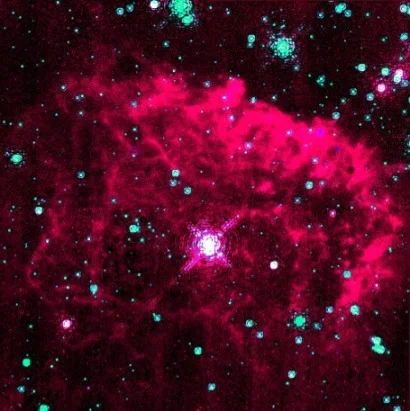
Pistol Star and Nebula (false colour composite image), photo: Don F. Figer (UCLA) and NASA
Located in the Galactic centre region, the Pistol Star lies approximately 25,000 light years from our solar system. Without the interstellar dust in the way, despite its distance it would be a fourth magnitude star, visible to the unaided eye.
The star was named after the shape of the nebula it illuminates, the Pistol Nebula.
Peony Star – WR 102ka
Peony Star, or WR 102ka, is one of the most luminous stars known in our galaxy. Named after the nebula that surrounds it – the Peony Nebula – the Peony Star is a Wolf-Rayet star with an absolute magnitude of -11.5. It lies at a distance of 26,100 light years from Earth. The star’s luminosity is uncertain – it is estimated to be about 3.2 million times that of the Sun – because the star is heavily obscured by dust and not visible in optical bands. It must be observed in infrared wavelengths.
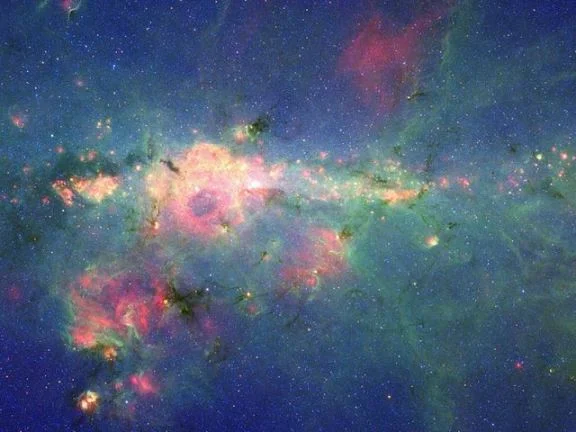
The image of the Peony Nebula star was taken by NASA’s Spitzer Space Telescope in its naturally dusty region. Image: NASA/JPL-Caltech/Potsdam Univ.
Peony Star has an estimated mass of about 100 solar masses and a radius 92 times solar. It is less that 3 million years old, but it has shed a lot of its initial mass and is expected to end its life in a supernova or hypernova event in the next few million years.
VX Sagittarii
VX Sagittarii, currently (as of 2017) one of the five largest known stars in the Milky Way, is an evolved red supergiant or hypergiant (M4eIa – M10eIa) with a radius between 1,350 and 1,940 times that of the Sun and a mass 12 times solar.
The star is classified as a semiregular variable of the SRc type. It has an apparent magnitude that varies from 6.5 to 14.0 over a pulsational period of 732 days. The star’s temperature is also variable and changes from about 2,500 K to 3,500 K, which is unprecedented in a star of this type. VX Sagittarii lies at an approximate distance of 5,150 light years from Earth.
WR 104
WR 104 is a triple star consisting of a Wolf-Rayet star and two hot blue main sequence companions. The star system lies approximately 8,400 light years away. The two brighter components form a close binary system with an apparent magnitude of 13.28. They orbit each other with a period of 241.5 days and are separated by only 2 astronomical units. The third star in the system is an O-type star with an apparent magnitude of 15.36. It is believed to be associated with the close binary.
The brighter two components – the Wolf-Rayet star and the class B companion – are massive enough to be supernova candidates, with masses 10 and 20 times that of the Sun. Since the rotational axis of the system points roughly in the direction of our planet, and fast-spinning Wolf-Rayet stars are believed to produce gamma-ray bursts along their rotational axes when they meet their end, there has been a lot of debate about whether Earth will be affected by the supernova. While the star is far enough for the supernova itself to be harmless, a long duration gamma-ray burst (LGRB) pointed in our direction could certainly do serious damage to our ozone layer. However, it is pretty unlikely that the star has a sufficiently high spin velocity to produce a LGRB and the exact inclination of its spin axis is uncertain.
Sakurai’s Object – V4334 Sagittarii
Sakurai’s Object is a so-called born again star, one that was originally a white dwarf but swelled into a red giant as a result of a late thermal pulse and is expected to evolve back into a white dwarf. Its final helium flash is expected to occur in the next few decades.
The star was discovered in February 1996 by Yukio Sakurai, an amateur astronomer. At the time, it was believed to be a magnitude 11.4 slow nova as it had not been visible in older images of the region and only appeared to brighten in the previous couple of years. By 1999, the star became invisible in optical wavelengths as a result of being obscured by a very thick shell of dust.
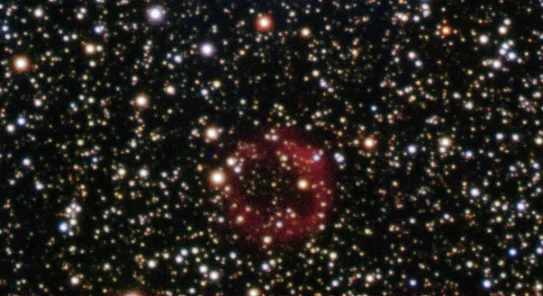
The bright star in the centre of this image is not the star of this show. At the bottom centre is a rather unremarkable smudge of red which is in fact a rare and valuable object. First discovered by amateur Japanese astronomer, Yukio Sakurai, in 1996, and noted as a nova-like object, Sakurai’s discovery turned out to be far more interesting than the supernova he initially supposed it to be. The object is actually a small white dwarf star undergoing a helium flash — one of only a handful of examples of such an event ever witnessed by astronomers. Normally, the white dwarf stage is the last in the life cycle of a low-mass star. In some cases, however, the star reignites in a helium flash and expands to return to a red giant state, ejecting huge amounts of gas and dust in the process, before once again shrinking to become a white dwarf. It is a dramatic and short-lived series of events, and Sakurai’s Object has allowed astronomers a very rare opportunity to study the events in real time. The white dwarf emits sufficient ultraviolet radiation to illuminate the gas it has expelled, which can just be seen in this image as the ring of red material. This image was taken using the FORS instrument, mounted on ESO’s Very Large Telescope. Image: ESO
The star lies at a center of a planetary nebula, formed after the star’s red giant stage about 8,300 years ago. The nebula expands at the velocity of about 32 km/s and occupies an area of 44 arc seconds.
KW Sagittarii
KW Sagittarii is one of the largest known stars. It is a red supergiant located about 10,000 light years from Earth, with an apparent magnitude varying between 8.5 and 11.The star’s diameter is 1,460 times the diameter of the Sun.
Polis – μ Sagittarii (Mu Sagittarii)
Mu Sagittarii is a multiple star system in Sagittarius, with individual components designated Polis A through Polis E. Its traditional name, Polis, comes from the Coptic Egyptian word for “foal.”
Polis is about 3,912 light years distant from Earth. The primary component in the star system is a class B giant 23 times as massive as the Sun, and 180,000 times more luminous. It is an eclipsing binary star, with a B8 supergiant star for a primary component and a B2 type giant as the companion star. The apparent magnitude of Polis A ranges from 3.84 to 3.96.
ρ Sagittarii (Rho Sagittarii)
Rho Sagittarii is a binary star with a subgiant belonging to the spectral class F0 as the primary component and a K0 type giant as the companion, separated by 0.46° from the primary. The subgiant has an apparent magnitude of 3.93 and is approximately 122 light years distant from the solar system. The companion star has an apparent magnitude of 5.84 and is located about 359 light years from Earth.
υ Sagittarii (Upsilon Sagittarii)
Upsilon Sagittarii is a spectroscopic binary star. It is one of only four star systems known to be hydrogen-deficient, which makes it difficult to classify U Sgr. Most likely, the primary component is an A type supergiant. It is classified as an irregular variable star, with an apparent magnitude varying from 4.51 to 4.65 with a period of about 20 days.
The companion star is more massive than the primary, but so faint that optical telescopes cannot detect it. The star is probably a B or O type main sequence dwarf that has accreted much of the primary star’s mass. The Upsilon Sagittarii system is about 1,672 light years distant and has an orbital period of 137.939 days.
Ross 154 (V1216 Sagittarii)
Ross 154 is a red dwarf only 9.68 light years away from the solar system. It is one of the closest stars to the Sun and the nearest star in Sagittarius constellation. It is located only 5.41 light years from Barnard’s Star in the neighbouring constellation Ophiuchus. The star is a relatively young one, with an estimated age of less than a billion years. It is a known X-ray source. It will make its closest approach to the Sun in about 150,000 years, when it comes within 6.13 light years of our solar system.
Ross 154 was originally catalogued by the American astronomer and physicist Frank Elmore Ross in 1925. It is classified as a UV Ceti-type flare star, one undergoing sudden dramatic increases in brightness for a few minutes. (Flare stars are typically dim red dwarfs or less massive brown dwarfs.)
V4641 Sagittarii
V4641 Sagittarii is the fourth known microquasar, discovered after four of the fastest X-ray intensity changes ever seen from a star. First detected in 1999, V4641 Sgr is a variable X-ray binary system once considered to be the closest black hole to Earth, at a distance of about 1,600 light years. It is now believed to be located at least 15 times farther away. The system is notable for being the source of one of the most rapid superluminal (faster than light) jets in our galaxy.
LBV 1806-20
LBV 1806-20, a candidate luminous blue variable (LBV) is one of the most luminous stars in our galaxy. Located 38,700 light years away, the star is likely a binary system. It has an absolute magnitude of -11 and a luminosity about 2 million times that of the Sun. Its estimated age is between 3 and 4.5 million years. The star cannot be observed in visual bands because less than a billionth of its light in the visible spectrum reaches us, which translates to about 35th visual magnitude. The star’s spectral type is estimated to be between O9 and B2 and may be variable.
At the time of discovery, LBV 1806-20 was thought to be the most luminous and most massive star ever discovered. It has a mass of about 36 solar masses, which now puts it behind more than a dozen massive stars, including four members of the Arches Cluster.
SGR 1806-20
The soft gamma repeater SGR 1806-20 is a magnetar, a neutron star with an exceptionally strong magnetic field, more than 1015 gauss (1011 tesla) in intensity , or 1-2 quadrillion (short scale) times that of the Earth. It is the most highly magnetized object ever discovered. The numbers 1806-20 indicate its position in the sky (right ascension and declination).
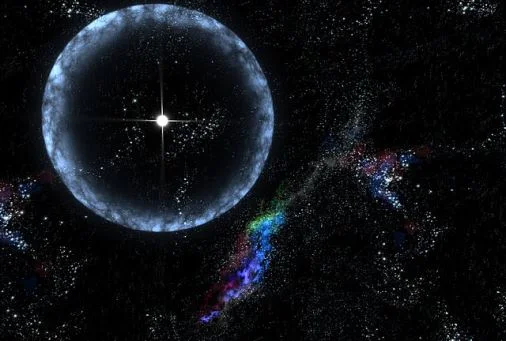
Artist conception of the December 27, 2004 gamma ray flare expanding from SGR 1806-20. Image: U Harvard
Soft gamma repeaters (SGR) are objects that emit enormous bursts of gamma-rays and X-rays at irregular intervals. They are believed to be a type of magnetar. The first magnetar to be identified, in 2013, was SGR J1745−2900 or PSR J1745-2900, the soft gamma repeater orbiting a black hole in Sagittarius A*.
SGR 1806-20 was identified as a soft gamma repeater in 1979. It lies at an estimated distance of 50,000 light years from Earth on the other side of our galaxy. It has a diameter of about 20 kilometres and its rotation speed at the surface is 30,000 km/h.
On 27 December, 2004, the brightest gamma ray burst ever detected outside the solar system was recorded emanating from the star, with an absolute magnitude of about -29. The burst was a result of a starquake, during which the magnetar released more energy in a tenth of a second than our Sun does in 100,000 years. This was the largest event of its kind seen in the Milky Way since 1604, when the type Ia supernova SN 1604 (Kepler’s Nova) was observed by the German astronomer Johannes Kepler in the direction of Ophiuchus constellation. The gamma ray burst was so powerful that it hit the Earth’s ionosphere and briefly expanded it.
Asterisms
The Teapot
Some of the brightest stars in Sagittarius – Delta, Epsilon, Gamma-2, Lambda, Zeta, Phi, Tau and Sigma Sagittarii – form an asterism known as the Teapot.
Sigma and Tau Sagittarii mark the handle, Delta, Epsilon, Zeta and Phi Sagittarii form the body of the Teapot, Lambda Sagittarii marks the point of the lid and Gamma-2 Sagittarii marks the tip of the spout.
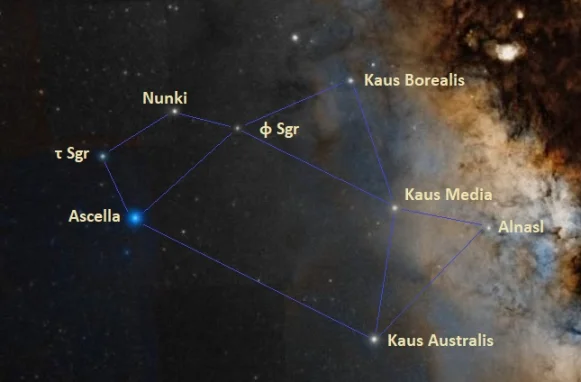
The Teapot in Sagittarius, image: Wikisky
The Terebellum
The Terebellum is a quadrilateral formed by four fourth magnitude stars in Sagittarius, all within two degrees of each other: Omega Sagittarii, 59 Sagittarii, 60 Sagittarii and 62 Sagittarii.
Omega Sagittarii is a G-type subgiant marking the northeast corner of the Terebellum, about 78 light years distant from Earth. 59 Sagittarii (sometimes also known as b Sagittarii) is a K-type bright giant at the southeast corner, about 1,200 light years distant. 60 Sagittarii (or A Sagittarii) is a G-type giant at the northwest corner of the asterism, approximately 340 light years away. 62 Sagittarii (or c Sagittarii) is an M-type giant at the southwest corner, about 450 light years from Earth. The star is classified as an irregular variable.
The stars are located at different distances from the solar system and are not gravitationally bound.
Deep sky objects in Sagittarius
Sagittarius A
Sagittarius A is a radio source located at the centre of the Milky Way, in the direction of the Sagittarius constellation. It is obscured from view by large cosmic dust clouds in the galaxy’s spiral arms.
Sagittarius A consists of the supernova remnant Sagittarius A East, the spiral structure Sagittarius A West, and a bright radio source located at the centre of the spiral, Sagittarius A*. The supernova remnant Sagittarius A East is about 25 light years wide and appears to have originated in an event that occurred between 35,000 and 100,000 years ago.
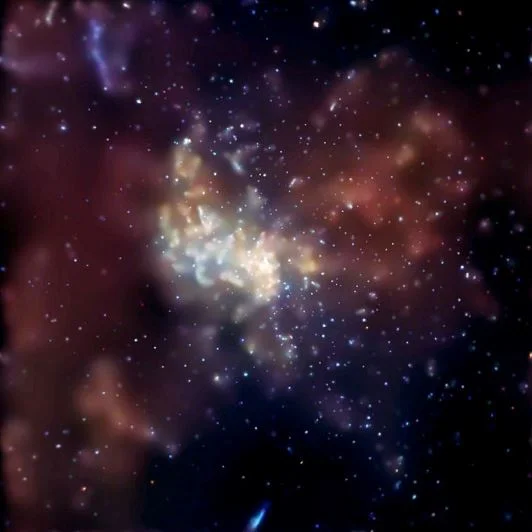
This Chandra image of Sgr A* and the surrounding region was made from a 164 hours of observation time over a two-week period. During this time the black hole flared up in X-ray intensity half a dozen or more times. The cause of these outbursts is not understood, but the rapidity with which they rise and fall indicates that they are occurring near the event horizon, or point of no return, around the black hole. Also discovered were more than two thousand other X-ray sources and huge lobes of 20 million-degree Centigrade gas (the red loops in the image at approximately the 2 o’clock and 7 o’clock positions). Image: NASA/CXC/MIT/F.K.Baganoff et al.
Because it has an imposing size and energy, Sagittarius A East is believed to be a remnant of a star that came close to the central black hole and was gravitationally compressed.
The spiral structure Sagittarius A West appears like a three-arm spiral and is sometimes called the Minispiral. It does not really have the structure of a spiral. It is made of clouds of dust and gas that circle Sagittarius A* and fall onto it at exceptionally high velocities, up to 1000 kilometres per second. The clouds have an ionized surface.
Sagittarius A* is the leading candidate for the location of the supermassive black hole believed to be at the centre of the Milky Way Galaxy. Stars orbit the object at speeds greater than those of any other stars found in the Milky Way.
Sagittarius B2
Sagittarius B2 is a very large molecular cloud of dust and gas approximately 390 light years from the centre of the Milky Way. Spanning an area of 150 light years across, Sagittarius B is one of the largest molecular clouds in our galaxy and the single largest one in the vicinity of the galaxy’s core. It has a mass three million times that of the Sun.
Lagoon Nebula – Messier 8 (M8, NGC 6523)
The Lagoon Nebula is a large interstellar cloud classified as an emission nebula. It is one of the several notable H II regions in Sagittarius. It has an apparent magnitude of 6.0 and is approximately 4,100 light years distant.
Messier 8 is one of only two nebulae that are star forming regions and can be seen by unaided eye. It was first discovered by the French astronomer Guillaume Le Gentil in 1747.
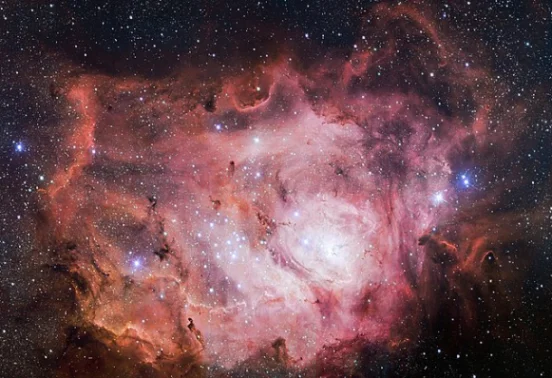
The VLT Survey Telescope (VST) at ESO’s Paranal Observatory in Chile has captured this richly detailed new image of the Lagoon Nebula. This giant cloud of gas and dust is creating intensely bright young stars, and is home to young stellar clusters. This image is a tiny part of just one of eleven public surveys of the sky now in progress using ESO telescopes. Together these are providing a vast legacy of publicly available data for the global astronomical community. Image: ESO/VPHAS+ team
At the centre of the Lagoon Nebula, there is a structure known as the Hourglass Nebula (not the same object as the famous Hourglass Nebula, which is located in the constellation Musca).
The Hourglass Nebula contains several Herbig-Haro objects, small patches of nebulosity indicating that there are newly born stars in the vicinity, and providing direct evidence of star forming activity in the region.
NGC 6530
NGC 6530 is an open cluster within the Lagoon Nebula. The brightest stars in the cluster are 7th magnitude. They are in fact located behind the nebula. The cluster has a diameter of 10 arc minutes and an apparent magnitude of 4.6. It was discovered by Italian astronomer Giovanni Battista Hodierna in 1654.
Omega Nebula – Messier 17 (M17, NGC 6618, Swan, Horseshoe or Lobster Nebula)
The Omega Nebula is an emission nebula in Sagittarius. It goes by many different names: Omega Nebula, Horseshoe Nebula, Lobster Nebula, Swan Nebula, Checkmark Nebula, and Sharpless 45.
The nebula is an H II region originally discovered by the Swiss astronomer Jean-Philippe Loys De Chéseaux in 1745. Messier included it in his catalogue in 1764.
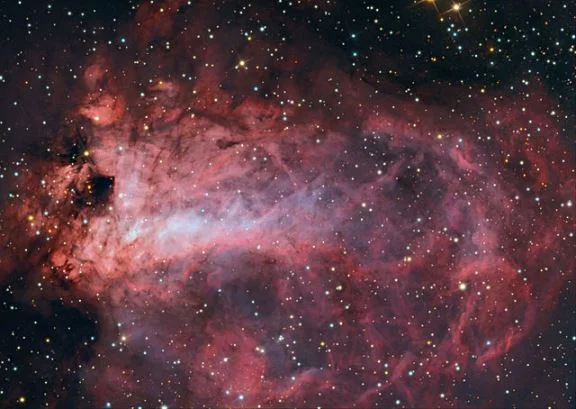
Omega Nebula (Messier 17), image: Adam Block/Mount Lemmon SkyCenter/University of Arizona (CC BY-SA 4.0)
The Omega Nebula has an apparent magnitude of 6.0 and is between 5,000 and 6,000 light years distant. It is about 15 light years in diameter.
The nebula contains an open cluster of 35 hot young stars which illuminate its gases.
Messier 18 (M18, NGC 6613)
Messier 18 is an open star cluster in Sagittarius. It was originally discovered by Charles Messier in 1764. It is believed to be about 32 million years old.
The cluster is nine light years in radius, has an apparent magnitude of 7.5, and is approximately 4,900 light years distant. It can be found between the Sagittarius Star Cloud (Messier 24) and the Omega Nebula (Messier 17).
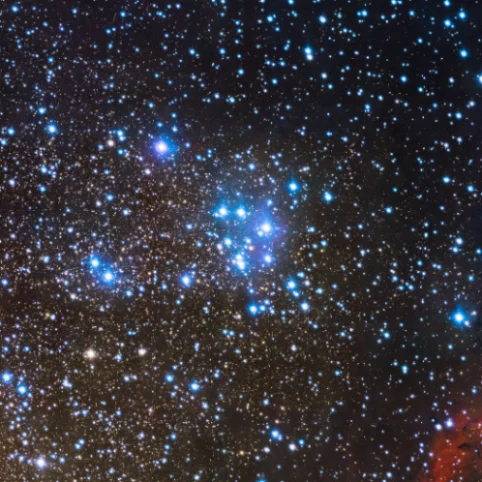
Messier 18, image: ESO
Trifid Nebula – Messier 20 (M20, NGC 6514)
The Trifid Nebula is a bright, colourful emission/reflection nebula in Sagittarius. The nebula is in fact a combination of an emission nebula (the lower part), a reflection nebula (the upper part) and an open cluster. It is an H II region, containing a stellar nursery full of embryonic stars.
The Trifid Nebula is about 28 arcminutes across in size. Its name means ‘divided into three lobes’. It can be observed through a small telescope and is a popular deep sky object among amateur astronomers.
The Trifid Nebula has an apparent magnitude of 6.3 and is approximately 5,200 light years distant.
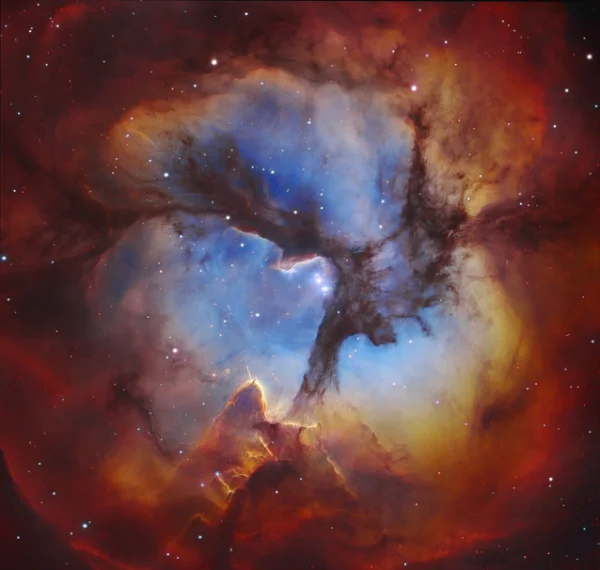
The central region of the Trifid Nebula (M20). Image: Subaru Telescope (NAOJ), Hubble Space Telescope, Martin Pugh; Processing: Robert Gendler
Messier 21 (M21, NGC 6531)
Messier 21 is another open star cluster in Sagittarius. It is a relatively young cluster, only 4.6 million years old, and it contains at least 57 stars. The cluster was first observed by Charles Messier in June 1764. He later included it in his catalogue.
M21 has an apparent magnitude of 6.5 and lies at an approximate distance of 4,250 light years from Earth.
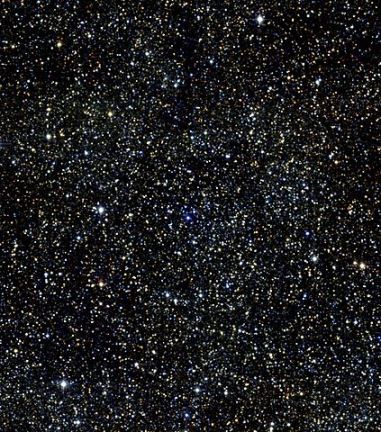
Messier 21, Atlas Image mosaic obtained as part of the Two Micron All Sky Survey (2MASS), a joint project of the University of Massachusetts and the Infrared Processing and Analysis Center/California Institute of Technology, funded by the National Aeronautics and Space Administration and the National Science Foundation.
Sagittarius Cluster – Messier 22 (M22, NGC 6656)
The Sagittarius Cluster is one of the brightest globular star clusters in the sky. It is elliptical in shape and about 32 arc minutes across in size. It has an apparent magnitude of 5.1 and is approximately 10,600 light years distant. It is one of the nearest globular star clusters to Earth.
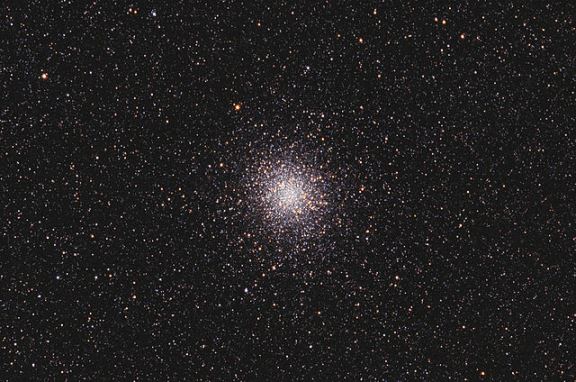
Messier 22, image: Wikimedia Commons/Hewholooks (CC BY-SA 3.0)
M22 was originally discovered by the German amateur astronomer Johann Abraham Ihle in 1665. Messier included the cluster in his catalogue in June 1764.
The Sagittarius Cluster is located near the galactic bulge, the central group of stars in the Milky Way.
It is also notable for being one of only four known globular clusters that contain a planetary nebula. (The other three are Messier 15 in the constellation Pegasus, Palomar 6 in Ophiuchus and NGC 6441 in Scorpius.)
The planetary nebula in the Sagittarius Cluster, designated GJJC1 is believed to be only 6,000 years old and has a blue star at the centre.
Messier 23 (M23, NGC 6494)
Messier 23 is an open star cluster, discovered by Charles Messier in June 1764. It has an estimated age of about 220 million years.
The cluster has an apparent magnitude of 6.9 and is about 2,150 light years distant. It is 15-20 light years in radius and contains about 150 stars. The brightest one has a magnitude of 9.2.
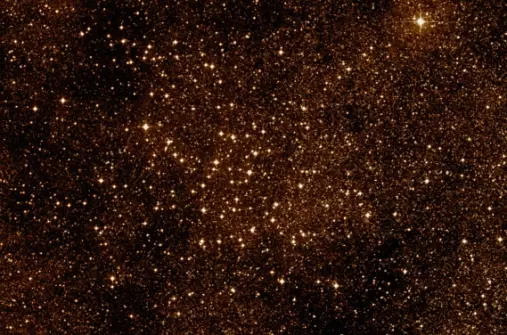
Messier 23, image: Wikisky
Small Sagittarius Star Cloud – Messier 24 (M24, NGC 6603, IC 4715)
The Small Sagittarius Star Cloud (Messier 24) is, as the name says, a star cloud in the constellation Sagittarius. It is the densest concentration of stars that can be seen using binoculars; about a thousand stars are visible within a single field of view.
The cloud is about 600 light years wide and approximately 10,000 light years distant. It was discovered by Charles Messier in 1764. Messier described the object as a “large nebulosity containing many stars.”
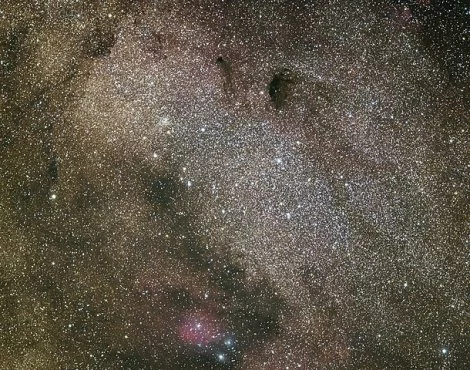
Small Sagittarius Star Cloud (Messier 24), image: Thomas Jäger (CC BY-SA 4.0)
The stars and clusters in the Sagittarius Star Cloud are part of the Sagittarius or Sagittarius-Carina spiral arms of the Milky Way. The Carina-Sagittarius Arm is particularly notable for containing a large number of H II regions, giant molecular clouds and young stars.
Messier 25 (M25, IC 4725)
Messier 25 is an open cluster with an apparent magnitude of 4.6, about 2,000 light years from Earth. The cluster is about 19 light years across. Its estimated age is 90 million years. It was discovered by Philippe Loys De Chéseaux in 1745 and added to Messier’s catalogue in 1764.
Messier 28 (M28, NGC 6626)
Messier 28 is a globular cluster located near Lambda Sagittarii (Kaus Borealis). It is between 18,000 and 19,000 light years distant and has an apparent magnitude of 7.66.
The cluster contains 18 RR Lyrae type variable stars. These are pulsating stars belonging to the spectral class A (and occasionally F), usually with a mass of about half the Sun’s, used as standard candles to measure galactic distances.
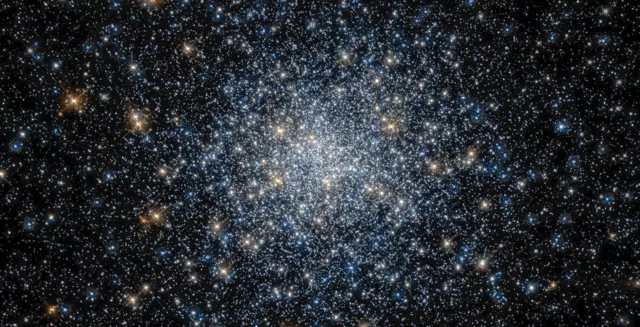
Messier 28, based on observations made with the NASA/ESA Hubble Space Telescope, and obtained from the Hubble Legacy Archive, which is a collaboration between the Space Telescope Science Institute (STScI/NASA), the Space Telescope European Coordinating Facility (ST-ECF/ESA) and the Canadian Astronomy Data Centre (CADC/NRC/CSA).
Messier 28 was the first globular star cluster in which a milisecond pulsar (a pulsar with a rotational period between 1 and 10 miliseconds) was discovered in 1986.
Messier 54 (M54, NGC 6715)
Messier 54 is a dense globular cluster with an apparent magnitude of 8.37, approximately 87,400 light years distant and about 150 light years across. The cluster was discovered by Charles Messier in 1778. Messier later included it in his catalogue.
M54 is believed to belong to the Sagittarius Dwarf Elliptical Galaxy. It lies close to the star Zeta Sagittarii.
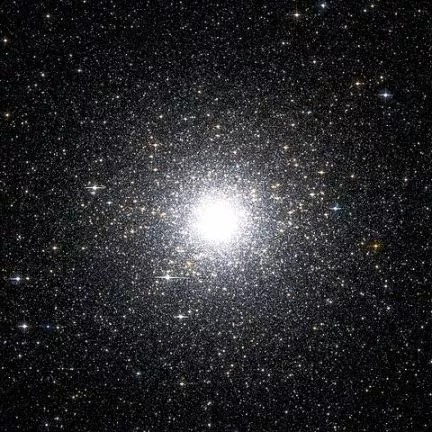
Messier 54, image: NASA/ESA
Messier 55 (M55, NGC 6809)
Messier 55 is another globular cluster in Sagittarius. It was discovered by the French astronomer Nicolas Louis de Lacaille in 1751 and included by Messier in his catalogue in 1778.
The cluster is a relatively large and bright one, with an apparent magnitude of 7.42. It is located approximately 17,300 light years from Earth.
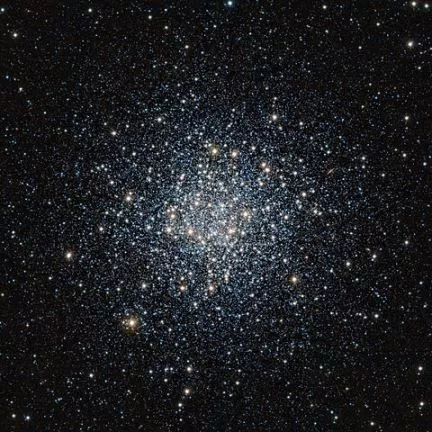
This striking view of the globular star cluster Messier 55 in the constellation of Sagittarius (the Archer) was obtained in infrared light with the VISTA survey telescope at ESO’s Paranal Observatory in Chile. This vast ball of ancient stars is located at a distance of about 17,000 light-years from Earth. Image: ESO/J. Emerson/VISTA
Messier 69 (M69, NGC 6637)
Messier 69 is a globular cluster. It was discovered by Charles Messier on August 31, 1780, along with another globular cluster, Messier 70. M69 has a radius of 42 light years and an apparent magnitude of 8.31. It contains very few variable stars.
M69 is only 1,800 light years away from M70 and located near the Galactic centre. It is approximately 29,700 light years distant from Earth.
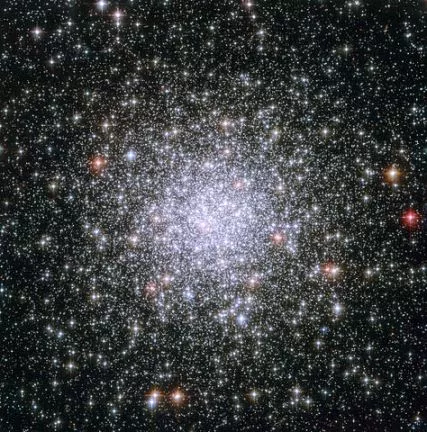
This dazzling image shows the globular cluster Messier 69, or M69 for short, as viewed through the NASA/ESA Hubble Space Telescope. Globular clusters are dense collections of old stars. In this picture, foreground stars look big and golden when set against the backdrop of the thousands of white, silvery stars that make up M69. Another aspect of M69 lends itself to the bejewelled metaphor: As globular clusters go, M69 is one of the most metal-rich on record. In astronomy, the term “metal” has a specialised meaning: it refers to any element heavier than the two most common elements in our Universe, hydrogen and helium. The nuclear fusion that powers stars created all of the metallic elements in nature, from the calcium in our bones to the carbon in diamonds. Successive generations of stars have built up the metallic abundances we see today. Because the stars in globular clusters are ancient, their metallic abundances are much lower than more recently formed stars, such as the Sun. Studying the makeup of stars in globular clusters like M69 has helped astronomers trace back the evolution of the cosmos. Image: ESA/Hubble & NASA
Messier 70 (M70, NGC 6681)
Messier 70 is a globular cluster in Sagittarius, located close to the Galactic centre. Charles Messier discovered it in 1780 and subsequently included it in his catalogue.
The cluster is about 34 light years in radius, has an apparent magnitude of 9.06 and is approximately 29,300 light years distant.
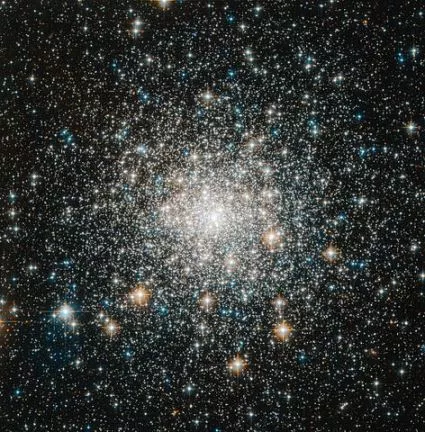
In this image, the NASA/ESA Hubble Space Telescope has captured the brilliance of the compact centre of Messier 70, a globular cluster. Quarters are always tight in globular clusters, where the mutual hold of gravity binds together hundreds of thousands of stars in a small region of space. Having this many shining stars piled on top of one another from our perspective makes globular clusters a popular target for amateur skywatchers and scientists alike. Messier 70 offers a special case because it has undergone what is known as a core collapse. In these clusters, even more stars squeeze into the object’s core than on average, such that the brightness of the cluster increases steadily towards its centre. The legions of stars in a globular cluster orbit about a shared centre of gravity. Some stars maintain relatively circular orbits, while others loop out into the cluster’s fringes. As the stars interact with each other over time, lighter stars tend to pick up speed and migrate out toward the cluster’s edges, while the heavier stars slow and congregate in orbits toward the centre. This huddling effect produces the denser, brighter centres characteristic of core-collapsed clusters. About a fifth of the more than 150 globular clusters in the Milky Way have undergone a core collapse. Image: ESA/Hubble & NASA
Messier 75 (M75, NGC 6864)
Messier 75 is a globular star cluster about 67,500 light years from Earth. It was discovered by the French astronomer Pierre Méchain in 1780.
The cluster is about 67 light years in radius and has an apparent magnitude of 9.18. It is a densely populated cluster, classified as class I.
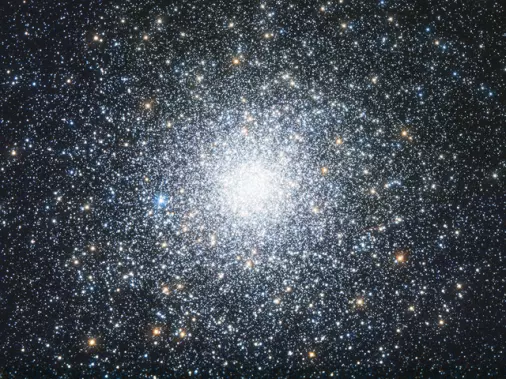
This beautiful image features the globular star cluster M75. The cluster has a highly concentrated core, with the majority of M75’s stars located in a large nucleus. In total, there are about 400,000 stars in the globular cluster. M75 is believed to be around 13 billion years old and sits approximately 67,500 light-years away from Earth. Located in the western part of Sagittarius, the cluster is surprisingly easy to see in binoculars and telescopes thanks to it being highly condensed in the center. However, because of its compact nature, M75 can barely be distinguished from a star when viewed in binoculars. Image: NASA, ESA, STScI, and G. Piotto (Università degli Studi di Padova), and E. Noyola (Max Planck Institut für extraterrestrische Physik)
Sagittarius Dwarf Elliptical Galaxy
The Sagittarius Dwarf Elliptical Galaxy (Sag DEG) is an elliptical galaxy shaped like a loop. Sometimes it is also called the Sagittarius I Dwarf or Sagittarius Dwarf Spheroidal.
It is a satellite galaxy of the Milky Way and headed for a collision with our galaxy. Sag DEG’s ellipse is already extended around our galaxy, and the main cluster will pass through the galactic disc of the Milky Way in the next million years.
The Sagittarius Dwarf is believed to already have orbited the Milky Way about 10 times in the last billion years or so, and it still appears to have coherence as an elongated ellipse despite being torn apart by enormous tidal forces as a result of the interaction.
The Sagittarius Dwarf Elliptical Galaxy has an apparent magnitude of 4.5 and is approximately 65,000 light years distant. It is located about 50,000 light years from the centre of the Milky Way.
The galaxy is about 10,000 light years in diameter and it consists of four globular star clusters, the main one of which was discovered in 1994. At the time, Sag DEG was the nearest known neighbouring galaxy of the Milky Way. (In 2003, the Canis Major Dwarf Galaxy was discovered and recognized as the nearest neighbour.)
The Sagittarius Dwarf Galaxy is an old galaxy, composed mainly of Population II stars (old, metal-poor stars). The globular cluster Messier 54 lies at the core of the galaxy.
NGC 6563
NGC 6563 is a planetary nebula located approximately 5,400 light-years way. It appears in the region west of Kaus Australis. It has an apparent magnitude of 10 and an apparent size of 0.7 arcminutes, corresponding to a linear radius of 0.398 light-years (0.122 parsecs).
The nebula’s central star shines at magnitude 17.49 and has an estimated mass od 2.932 solar masses. With an effective temperature of 123,000 K, it is 69 times more luminous than the Sun.
The nebula was discovered by the Scottish astronomer James Dunlop in 1826. It has an estimated age of 6,350 years.
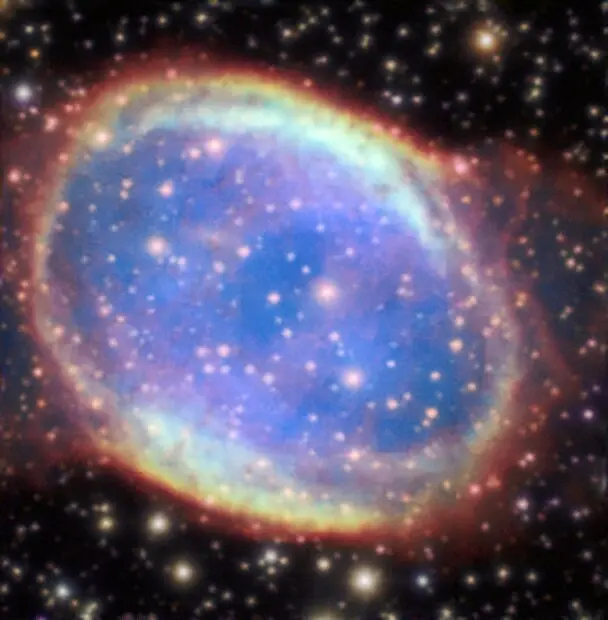
The planetary nebula NGC 6563 observed with the Adaptive Optics Facility (AOF), image credit: ESO/P. Weilbacher (AIP) (CC BY 4.0)
NGC 6565
NGC 6565 is a planetary nebula, a cloud of gas expelled by a central star in its final stages, located about 14,000 light years away in Sagittarius.
The nebula has an apparent size of only 10 by 8 arc seconds and an apparent magnitude of 13. It is also catalogued as ESO 456-70. The nebula was discovered by Edward Charles Pickering on July 14, 1880.
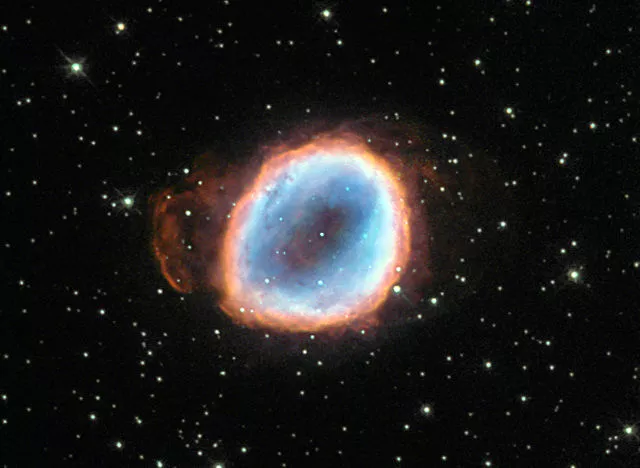
A star’s final moments are captured in this image from the NASA/ESA Hubble Space Telescope. The end of this star may only last mere moments on a cosmological timescale, but this star’s demise is still quite lengthy by our standards, lasting tens of thousands of years! The star’s agony has culminated in a wonderful planetary nebula known as NGC 6565, a cloud of gas that was ejected from the star after strong stellar winds pushed the star’s outer layers away into space. Once enough material was ejected, the star’s luminous core was exposed and it began to produce ultraviolet radiation, exciting the surrounding gas to varying degrees and causing it to radiate in an attractive array of colours. These same colours can be seen in the famous and impressive Ring Nebula (heic1310), a prominent example of a nebula like this one. Planetary nebulae are illuminated for around 10 000 years before the central star begins to cool and shrink to become a white dwarf. When this happens, the star’s light drastically diminishes and ceases to excite the surrounding gas, so the nebula fades from view. Image: ESA/Hubble & NASA, acknowledgement: M. Novak
Arches Cluster
The Arches Cluster is the densest open cluster known in the Milky Way. Located 25,000 light years from Earth, the cluster lies only about 100 light years from the Galactic centre. Obscured by clouds of dust, it cannot be observed in the visual bands, but is visible in radio, infrared and X-ray wavelengths.
The cluster contains some of the brightest, most massive stars in our galaxy. The most prominent members are Wolf-Rayet stars and O-type supergiants. The cluster is believed to be only 2.5 million years old. With a mass of 10,000 solar masses, it is about 10 times more massive than typical open clusters in the Milky Way.
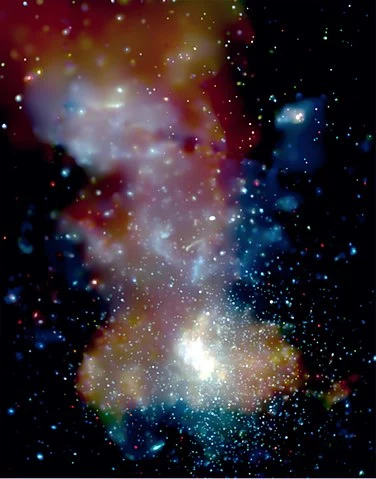
The clusters, Arches (upper right), Quintuplet (upper center), and the GC cluster (bottom center), contain massive stars that appear as very bright, point-like X-ray sources when winds from their surfaces collide with those from an orbiting companion. Vast amounts of energy are also released when these stars go out as supernovas, heating the surrounding material. Stellar corpses in this image also emit X-rays as either neutron stars or black holes in binary systems. Collisions between the clusters themselves and cooler molecular clouds of gas contribute to the diffuse X-rays seen in this image. Image: Smithsonian Institution, NASA/CXC/UMass Amherst/Q.D.Wang et al.
Quintuplet Cluster
The Quintuplet Cluster is another dense open cluster located in same region as the Arches Cluster, about 26,000 light years from Earth and 100 light years from the centre of the Milky Way. Named for its most prominent five stars, the cluster was only discovered in 1990. It cannot be seen visually, but must be observed in radio, X-ray and infrared bands.
The Quintuplet Cluster contains more Wolf-Rayet stars than any other cluster known and several notable luminous blue variables, including the Pistol Star, V4650 Sagittarii and the runaway star V4998 Sagittarii.
Sagittarius Dwarf Irregular Galaxy
The Sagittarius Dwarf Irregular Galaxy (Sag DIG) is a dwarf galaxy located in Sagittarius, approximately 3.39 million light years from the solar system. It has an apparent magnitude of 15.5.
The galaxy was discovered on a photographic plate taken for the ESO Atlas in June 1977.
The Sagittarius Dwarf Irregular Galaxy contains mainly intermediate-age stars as a result of a prolonged period of star formation. It is one of the most metal-poor galaxies known.
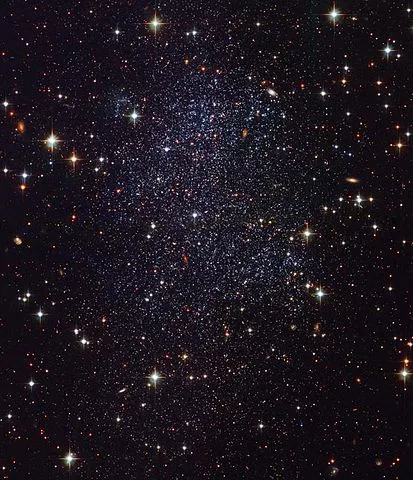
Sagittarius Dwarf Irregular Galaxy (SagDIG), image: NASA, ESA, and The Hubble Heritage Team (STScI/AURA), acknowledgement: Y. Momany (University of Padua)
NGC 6578
NGC 6578 is a planetary nebula occupying an area of 8 arc seconds. It has an apparent magnitude of 13.5 and can be seen near the star 16 Sagittarii.
The nebula lies at a distance of 7,800 light years from Earth and has a 16th magnitude central star. It was discovered by Edward Charles Pickering on August 18, 1882.
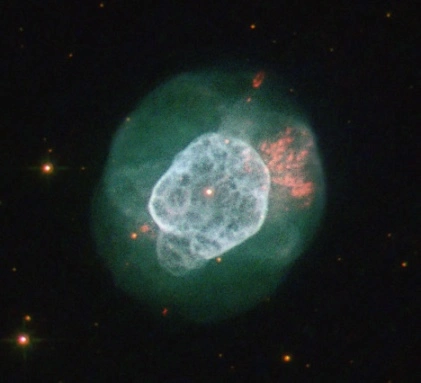
NGC 6578, image: Judy Schmidt (CC BY 2.0)
NGC 6522
NGC 6522 is a globular cluster with an apparent magnitude of 10.5, lying at a distance of 25,100 light years from Earth. The brightest stars in the cluster are 16th magnitude. The estimated age of the cluster is more than 12 billion years, making NGC 6522 one of the oldest known clusters in the Milky Way.
The cluster occupies an area of 2′ of apparent sky. It lies in an area of the sky known as Baade’s Window. The region has relatively low amounts of dust and allows a view of the Galactic centre. The cluster was discovered by William Herschel on 24 June, 1784.
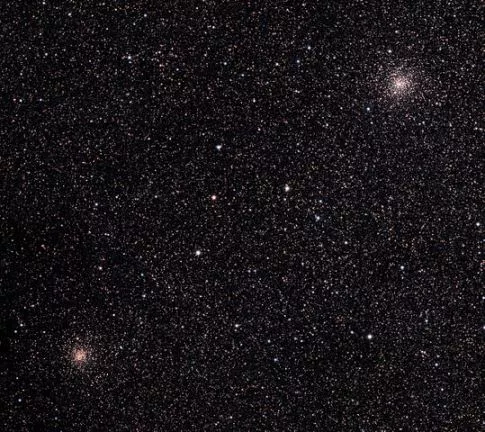
The clusters NGC 6522 and NGC 6528. Image: Wikimedia Commons/Jschulman555 (CC BY-SA 4.0)
NGC 6528
NGC 6528 is another globular cluster, located just to the southwest of NGC 6522. It was discovered by William Herschel in 1784 using his 18-inch telescopes. The cluster has an apparent magnitude of 10.65 and lies 25,800 light years from Earth. It is 8.3′ by 8.3′ in diameter. The brightest stars in the cluster are 16th magnitude.
Barnard’s Galaxy – NGC 6822 (IC 4895, Caldwell 57)
NGC 6822 is a barred irregular galaxy that belongs to the Local Group of galaxies. It has a similar structure to the Small Magellanic Cloud, the dwarf galaxy in the constellation Tucana.
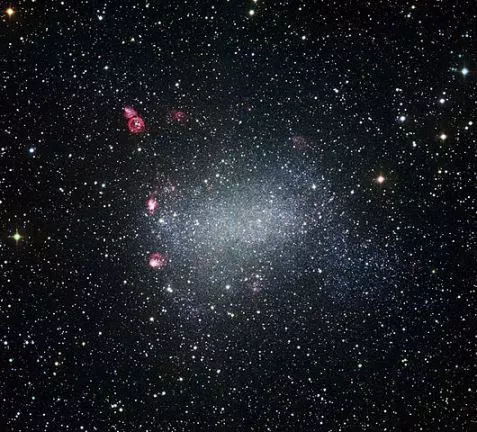
Astronomers obtained this portrait of Barnard’s Galaxy using the Wide Field Imager attached to the 2.2-metre MPG/ESO telescope at ESO’s La Silla Observatory in northern Chile. Also known as NGC 6822, this dwarf irregular galaxy is one of the Milky Way’s galactic neighbours. The dwarf galaxy has no shortage of stellar splendour and pyrotechnics. Reddish nebulae in this image reveal regions of active star formation, wherein young, hot stars heat up nearby gas clouds. Also prominent in the upper left of this new image is a striking bubble-shaped nebula. At the nebula’s centre, a clutch of massive, scorching stars send waves of matter smashing into surrounding interstellar material, generating a glowing structure that appears ring-like from our perspective. Other similar ripples of heated matter thrown out by feisty young stars are dotted across Barnard’s Galaxy. The image was made from data obtained through four different filters (B, V, R, and H-alpha). The field of view is 35 x 34 arcmin. Image: ESO
NGC 6822 has an apparent magnitude of 9.3 and is approximately 1.63 million light years distant.
The galaxy was named after the American astronomer E.E. Barnard, who discovered it in 1881 using a six-inch refractor telescope.
Edwin Hubble identified 15 variable stars in Barnard’s Galaxy, 11 of which were Cepheids, luminous variable stars that have a strong relationship between luminosity and pulsation period, which makes them excellent standard candles (objects with a known luminosity) for determining galactic and extragalactic distance scales.
Hubble established a distance of over 700,000 light years using the Cepheids’ period-luminosity relationship, and this was the first system located beyond the Magellanic Clouds to have its distance accurately determined.
The Bubble Nebula (Hubble 1925 I)
The Bubble Nebula is an emission nebula located in Barnard’s Galaxy. It contains areas of massive H II emission, large clouds of partly ionized gas which show evidence of recent star forming activity.
NGC 6723
NGC 6723 is a globular star cluster in Sagittarius, near the border with Corona Australis. The cluster has an apparent magnitude of 6.8 and lies at a distance of 28,400 light years from Earth. It was discovered by James Dunlop on June 2, 1826.
The cluster spans about 65 light years and occupies about 11 arc minutes of the apparent sky. It has an estimated age of 13.06 billion years.
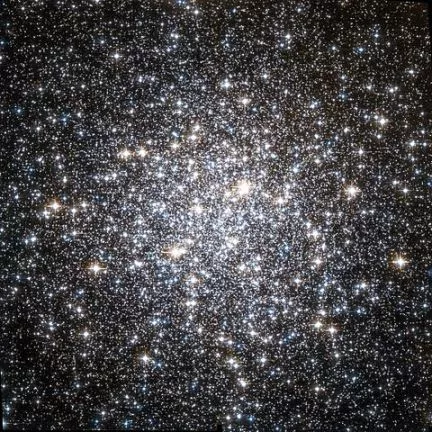
NGC 6723, image: NASA/ESA
Little Gem Nebula – NGC 6818
NGC 6818 is a magnitude 10 planetary nebula in Sagittarius. The nebula was first discovered by William Herschel in 1787. Its inner elongated shape is believed to be the result of a fast wind of material travelling away from the hot 15th magnitude central star.
The nebula lies at a distance of 6,000 light years from Earth and has an oval diameter of 15 to 22 arcseconds.
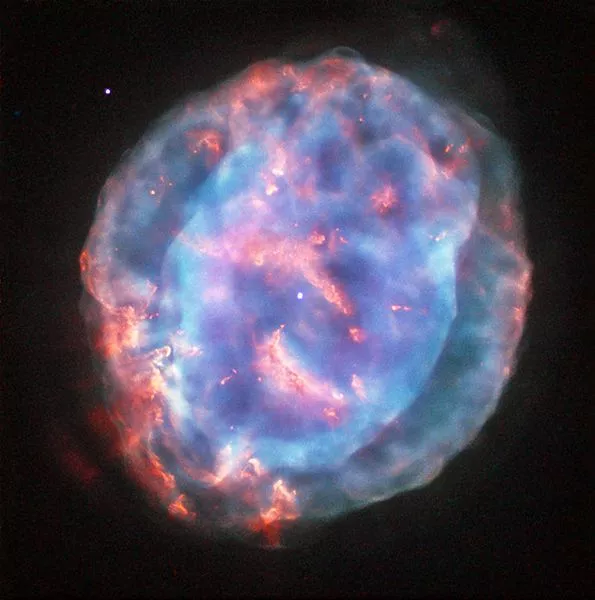
Little Gem Nebula, image: Judy Schmidt (CC BY 2.0)
Eye of Sauron Nebula – M 1-42
M 1-42 is another planetary nebula in the constellation, located at a distance of 10,000 light years from Earth. The nebula’s appearance earned it the nickname “Eye of Sauron Nebula.” Also catalogued as ESO 456-67, the nebula was discovered by Rudolph Minkowski in 1946.
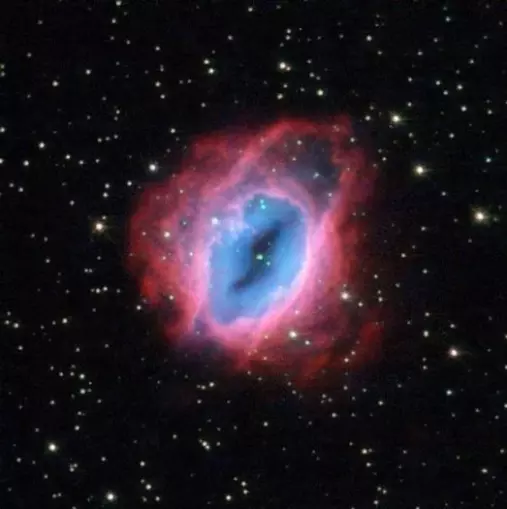
It may look like something from “The Lord of the Rings,” but this fiery swirl is actually a planetary nebula known as ESO 456-67. Set against a backdrop of bright stars, the rust-colored object lies in the constellation of Sagittarius (The Archer), in the southern sky. In this image of ESO 456-67, it is possible to see the various layers of material expelled by the central star. Each appears in a different hue – red, orange, yellow, and green-tinted bands of gas are visible, with clear patches of space at the heart of the nebula. It is not fully understood how planetary nebulae form such a wide variety of shapes and structures; some appear to be spherical, some elliptical, others shoot material in waves from their polar regions, some look like hourglasses or figures of eight, and others resemble large, messy stellar explosions – to name but a few. Image: ESA/Hubble and NASA
NGC 6589
NGC 6589 is a reflection nebula that occupies an area of 5.0′ by 3.0′ in apparent size. The nebula was discovered by Truman Safford on 28 August, 1867. Edward Emerson Barnard catalogued it as IC 4690 in August 1905.
Henize 3-1475 (IRAS 17423-1755)
The planetary nebula Henize 3-1475, also catalogued as IRAS 17423-1755, lies at an approximate distance of 18,000 light years from Earth. It has an apparent magnitude of 12.87.
The nebula’s central star is more than 12,000 times more luminous than the Sun.
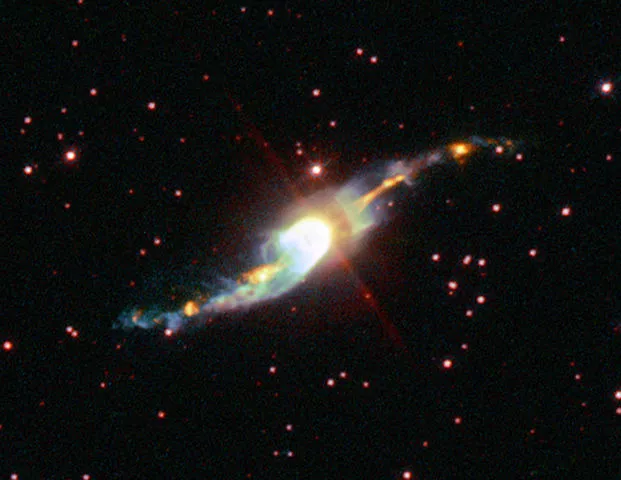
A Hubble Space Telescope photo of the planetary nebula Henize 3-1475. It is located about 18,000 light years away from Earth in the Sagittarius constellation. Astronomers have nicknamed it the ‘Garden-sprinkler’ Nebula due to its appearance. Image: European Space Agency, A. Riera (Universitat Politecnica de Catalunya, Spain) and P. Garcia-Lario (European Space Agency ISO Data Centre, Spain).
NGC 6544
NGC 6544 is a globular cluster located less than a degree southeast of the Lagoon Nebula. The small cluster is only 1 arc minute in diameter. It has an apparent magnitude of 9 and lies 9,450 light years from Earth. The cluster was discovered by William Herschel in 1784.
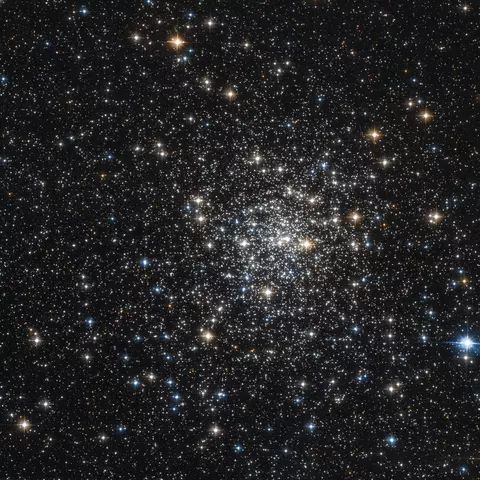
NGC 6544, based on observations made with the NASA/ESA Hubble Space Telescope, and obtained from the Hubble Legacy Archive, which is a collaboration between the Space Telescope Science Institute (STScI/NASA), the Space Telescope European Coordinating Facility (ST-ECF/ESA) and the Canadian Astronomy Data Centre (CADC/NRC/CSA).
Westerhout 31
Westerhout 31 (W31) is a massive H II region in Sagittarius. The complex of star forming regions is obscured by interstellar dust, but it can be observed in radio, infrared and X-ray bands. The several star forming regions that make up W31 are located at different distances, but appear together in the sky because they lie in the same line of sight when observed from Earth.
The most notable of these regions, the radio-emitting nebula G10.3-0.3, is home to the cluster 1806-20, which contains an O-type supergiant, two blue hypergiants, three Wolf-Rayet stars, the luminous blue variable LBV 1806-20 and the magnetar SGR 1806-20.
The closest complex of regions in W31 is formed by G10.2-0.3 and G10.6-0.4. It contains a young cluster, with an estimated age of 0.6 million years, which has at least four O-type stars and five massive young stellar objects (YSOs).
1806-20
The star cluster 1806-20 is home to many massive stars that are expected to end their lives as supernovas in the next few million years. It lies at an approximate distance of 50,000 light years from Earth. Located on the far side of our galaxy, the cluster is heavily obscured by dust, but visible in infrared wavelengths.
1806-20 contains at least three Wolf-Rayet stars, an OB supergiant, the soft gamma repeater SGR 1806-20 and LBV 1806-20, once of the most luminous stars in the Milky Way.
Terzan 7
Terzan 7 is the brightest of the six globulars discovered by Agop Terzan in 1968. It has an apparent magnitude of 12 and with a linear radius of 160 light years it occupies 7.3′ of the apparent sky.
It is a sparse cluster with an estimated age of only 7.5 billion years. The cluster’s age and low levels of nickel found in it led astronomers to believe that it may have originated in the Sagittarius Dwarf Spheroidal Galaxy (Sag DEG).
Terzan 7 has a considerable number of blue stragglers and the cluster’s centre has a particularly high concentration of these stars. The cluster is located at a distance of 75,700 light years from Earth.
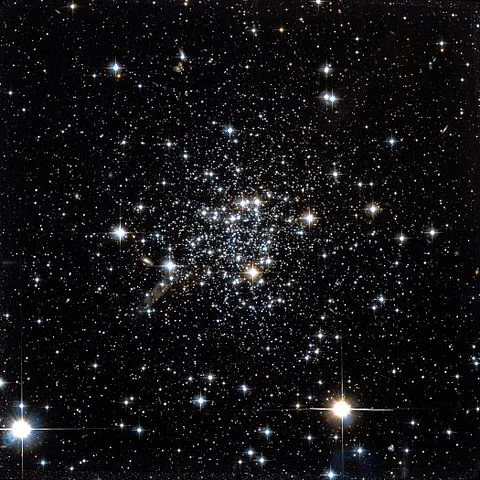
Evidence shows that Terzan 7 used to belong to a small galaxy called the Sagittarius Dwarf Galaxy, a mini-galaxy discovered in 1994. This galaxy is currently colliding with, and being absorbed by, the Milky Way, which is a monster in size when compared to this tiny one. It seems that this cluster has already been kidnapped from its former home and now is part of our own galaxy. Astronomers recently discovered that all the stars in Terzan 7 were born at around the same time, and are about eight billion years old. This is unusually young for such a cluster. The shared birthday is another uncommon property; a large number of globular clusters, both in the Milky Way and in other galaxies, seem to have at least two clearly differentiated generations of stars that were born at different times. Some explanations suggest that there is something different about clusters that form within dwarf galaxies, giving them a different composition. Others suggest that clusters like Terzan 7 only have enough material to form one batch of stars, or that perhaps its youthfulness has prevented it from yet forming another generation. Image: NASA, ESA, and A. Sarajedini (University of Florida) Acknowledgement: Gilles Chapdelaine
Terzan 5
Terzan 5 is a globular cluster about 18,800 light years away in the Milky Way bulge. The cluster is heavily obscured and has an apparent magnitude of 12.8. It has a half-mass diameter of 1’02” and linear radius of 2.7 light years. The cluster is one of six globulars discovered by the French-Armenian astronomer Agop Terzan in 1968.
Terzan 5 has a mass of about 2 million solar masses and bolometric luminosity 800,000 times that of the Sun.
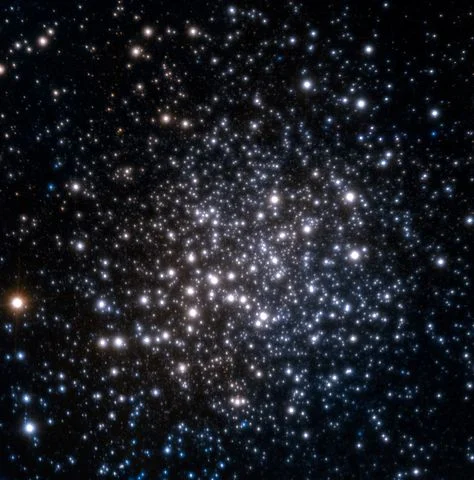
Peering through the thick dust clouds of our galaxy’s central parts (the “bulge”) with an amazing amount of detail, a team of astronomers has revealed an unusual mix of stars in the stellar grouping known as Terzan 5. Never observed anywhere in the bulge before, this peculiar cocktail of stars suggests that Terzan 5 is in fact one of the bulge’s primordial building blocks, most likely the relic of a dwarf galaxy that merged with the Milky Way during its very early days. Image: ESO/F. Ferraro
The cluster’s small central region has one of the highest star densities in the Milky Way. Observations in 2009 revealed that the cluster contains at least two generations of stars, one with an estimated age of 12 billion years and another about 4.5 billion years old.
This may indicate that, like the better known Messier 54 and Omega Centauri, Terzan 5 is not a true globular cluster, but possibly the remaining core of a dwarf galaxy disrupted by the Milky Way in the distant past.
Terzan 5 contains at least 34 and up to 200 milisecond radio pulsars (pulsars with a rotational period of 1-10 miliseconds), including PSR J1748-2446ad, the fastest spinning pulsar known, which rotates 716 times a second with a rotation period of 1.40 miliseconds. At the equator, the pulsar is spinning at a speed of more than 70,000 km/s, or about 24% of the speed of light. PSR J1748-2446ad was discovered on 10 November, 2004.
Red Spider Nebula – NGC 6537
The Red Spider Nebula is a planetary nebula that occupies an area of 1.5 arc minutes in the northwestern part of Sagittarius. It has an apparent magnitude of 13 and lies at an estimated distance between 3,000 and 8,000 light years from Earth.
The two-lobed nebula surrounds the central hot white dwarf that produces a hot wind with a speed of 300 km/s. The estimated temperature of the central star, one of the hottest known white dwarfs, is between 150,000 and 250,000 K, and possibly higher. The nebula was discovered by Edward Charles Pickering on July 15, 1882.
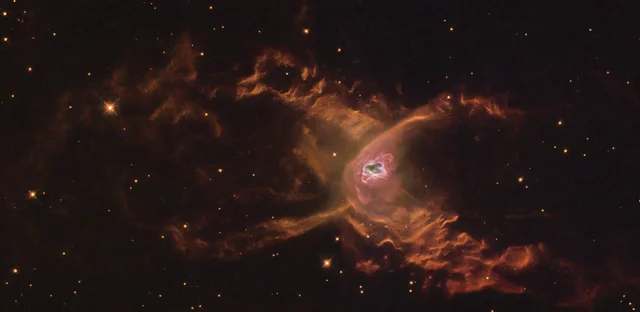
Red Spider Nebula (NGC 6537), image: Judy Schmidt (CC BY 2.0)
NGC 6440
NGC 6440 is another globular cluster in Sagittarius. It has an apparent magnitude of 10.10 and lies at a distance of 27,700 light years.
The cluster has a diameter of about 6 arc minutes. It was discovered by William Herschel on May 28, 1786.
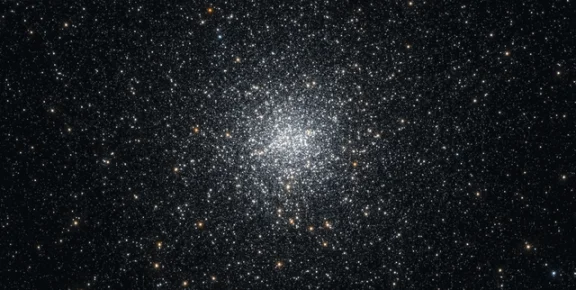
NGC 6440, based on observations made with the NASA/ESA Hubble Space Telescope, and obtained from the Hubble Legacy Archive, which is a collaboration between the Space Telescope Science Institute (STScI/NASA), the Space Telescope European Coordinating Facility (ST-ECF/ESA) and the Canadian Astronomy Data Centre (CADC/NRC/CSA).
Box Nebula – NGC 6445
The Box Nebula, catalogued as NGC 6445, is a planetary nebula with a visual magnitude of 11.2. The nebula spans about 35″ and is located only 0.36 arc minutes from the cluster NGC 6440. It was discovered by William Herschel on May 28, 1786.
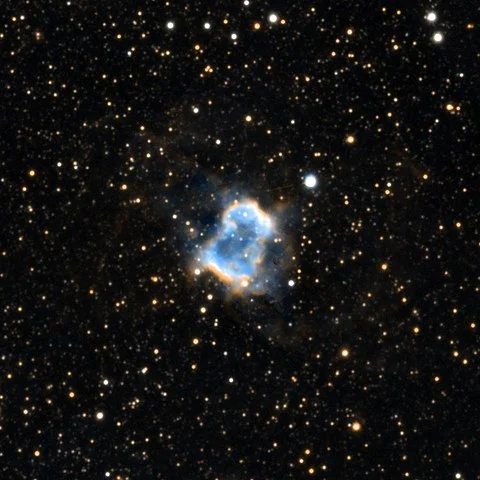
Box Nebula (NGC 6445), image: NASA and STScI
NGC 6559
NGC 6559 is a star-forming region consisting of emission and reflection nebulae and dark absorption nebulae, lying about 5,000 light years from Earth.
It is located about a degree to the east of Messier 8, the more famous and much larger Lagoon Nebula. The two nebulae are probably part of the same larger star-forming region.
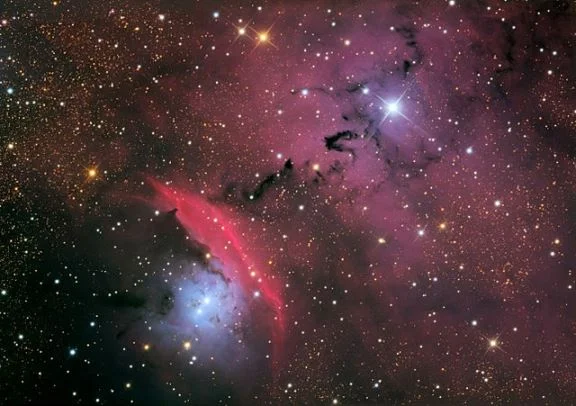
NGC 6559, image: Adam Block/Mount Lemmon SkyCenter/University of Arizona (CC BY-SA 3.0 US)
NGC 6638
NGC 6638 is a class VI globular cluster occupying an area of 2 arc minutes about half a degree to the east of Lambda Sagittarii. The cluster has an apparent magnitude of 9.5. It was discovered by William Herschel in 1784.
NGC 6624
NGC 6624 is another globular cluster in Sagittarius. It has an apparent magnitude of 7.6 and is 25,800 light years distant from Earth and about 3,800 light years away from the Galactic centre.
The cluster can be seen only 0.8 degrees to the southeast of Delta Sagittarii. It occupies an area 8.8 arc minutes in size. It was discovered by William Herschel on June 24, 1784.
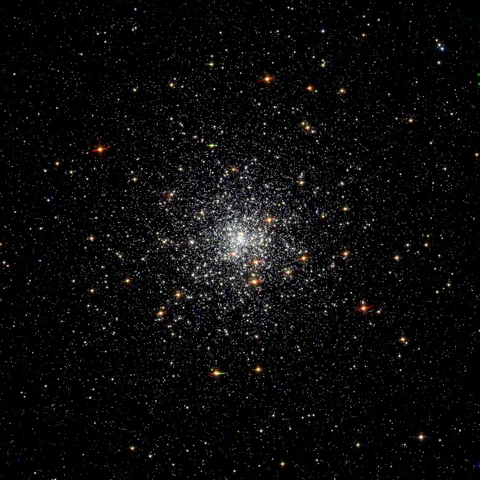
NGC 6624, based on observations made with the NASA/ESA Hubble Space Telescope, and obtained from the Hubble Legacy Archive, which is a collaboration between the Space Telescope Science Institute (STScI/NASA), the Space Telescope European Coordinating Facility (ST-ECF/ESA) and the Canadian Astronomy Data Centre (CADC/NRC/CSA).
NGC 6624 contains six confirmed pulsars and a low-mass X-ray binary, designated 4U 1820-30, with an orbital period of only 11.5 minutes.
NGC 6520
NGC 6520 is an open star cluster with an apparent magnitude of 9.0. The cluster spans 10 light years and has an apparent size of 5 arc minutes. It lies at a distance of 5,500 light years from Earth. About 25 stars in the cluster are of magnitude 9 to 12.
The dark nebula Barnard 86 (B86) can be seen near the cluster’s western edge.
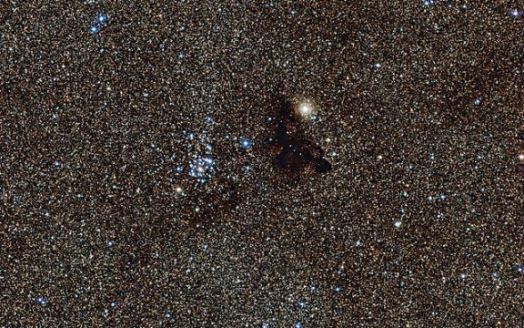
This image from the Wide Field Imager on the MPG/ESO 2.2-metre telescope at ESO’s La Silla Observatory in Chile, shows the bright star cluster NGC 6520 and its neighbour, the strangely shaped dark cloud Barnard 86. This cosmic pair is set against millions of glowing stars from the brightest part of the Milky Way — a region so dense with stars that barely any dark sky is seen across the picture.
This part of the constellation of Sagittarius (The Archer) is one of the richest star fields in the whole sky — the Large Sagittarius Star Cloud. The huge number of stars that light up this region dramatically emphasise the blackness of dark clouds like Barnard 86, which appears at the centre of this new picture from the Wide Field Imager, an instrument mounted on the MPG/ESO 2.2-metre telescope at ESO’s La Silla Observatory in Chile. Image: ESO, 2013
NGC 6717
NGC 6717 is a globular cluster 23,100 light years away. It has an apparent magnitude of 9.28. The cluster was discovered by William Herschel on August 7, 1784.
Hurt 2 – 2MASS-GC02
Hurt 2, or 2MASS-GC02, is a globular cluster discovered only recently, in 2000. It was named after R. J. Hurt, who led the team that confirmed the discovery.
The cluster lies at a distance of about 16,000 light years and has a magnitude of 9.30. It cannot be seen in visual bands as a result of interstellar extinction, but was discovered in infrared observations.
The cluster lies only 10,400 light years from the Galactic centre. It has a radius of 0.95 arc minutes.
NGC 6553
NGC 6553 is a globular cluster found just over a degree to the southeast of the Lagoon Nebula. The cluster has a visual magnitude of 8.06 and lies at a distance of 19,600 light years from Earth. The brightest stars in the cluster are 20th magnitude.
NGC 6553 is loosely concentrated and has an apparent diameter of 8.2 arc minutes. It was discovered by William Herschel on May 22, 1784.
Ruprecht 147 – NGC 6774
Ruprecht 147, also catalogued as NGC 6774, is a dispersed open cluster in Sagittarius. The cluster is so sparse that it was once considered to be an asterism. It lies at a distance of only 1,000 light years and has a radius of more than 9 light years, occupying more than 60 arc minutes of the apparent sky.
The stars in the cluster are between 2.5 and 3.25 billion years old. The cluster was discovered by John Herschel in 1830.
NGC 6558
NGC 6558 is a globular cluster that can be seen 1.5 degrees to the south-southeast of Gamma-2 Sagittarii. The cluster has an apparent magnitude of 11.29 and lies at a distance of 24,100 light years from Earth. It has an apparent size of 5.2′ by 5.2′. The cluster was discovered by William Herschel in 1784 using his 18.7-inch telescope.
NGC 6569
NGC 6569 is another globular cluster visible in the vicinity of Gamma-2 Sagittarii, about 2 degrees south of the star. The cluster has an apparent diameter of 7 arc minutes and a visual magnitude of 9.47. It lies at a distance of 35,500 light years. The brightest stars in the cluster shine at magnitude 15. The cluster was discovered by William Herschel in 1784.
NGC 6540
NGC 6540 is a globular cluster with an apparent magnitude of 9.30, located at a distance of 17,300 light years from Earth. It has an apparent size of 4.75′ by 4.75′. The cluster was discovered by William Herschel on May 24, 1784.